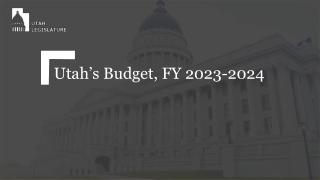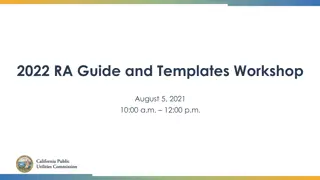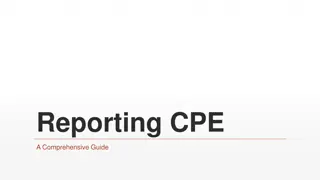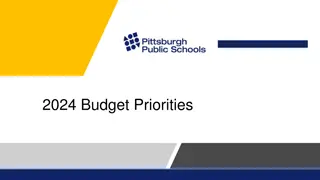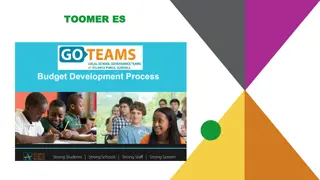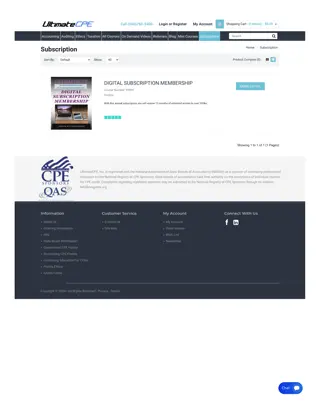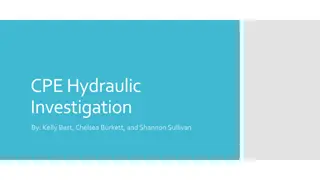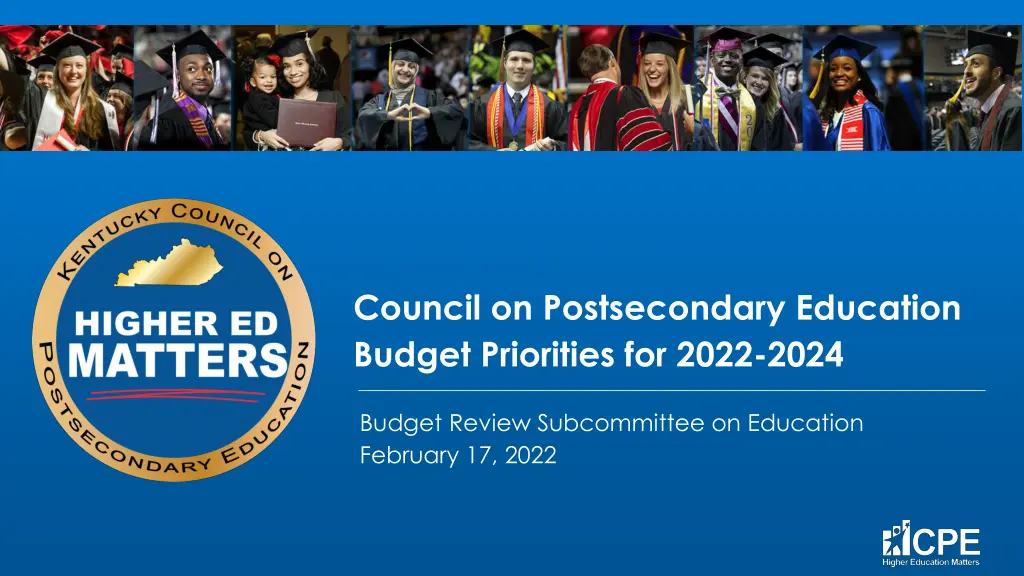
Postsecondary Education Budget Priorities and Responsibilities 2022-2024 Review
Explore the budget priorities, decreased funding, expanded duties, and responsibilities of the Council on Postsecondary Education for 2022-2024. Gain insights into the agency's general fund budget components, revised personnel, and progress towards the 60x30 goal. From overseeing Kentucky State University to managing COVID-19 funds, discover the impactful initiatives undertaken by the council since 2008 to strengthen postsecondary education in Kentucky.
Download Presentation

Please find below an Image/Link to download the presentation.
The content on the website is provided AS IS for your information and personal use only. It may not be sold, licensed, or shared on other websites without obtaining consent from the author. If you encounter any issues during the download, it is possible that the publisher has removed the file from their server.
You are allowed to download the files provided on this website for personal or commercial use, subject to the condition that they are used lawfully. All files are the property of their respective owners.
The content on the website is provided AS IS for your information and personal use only. It may not be sold, licensed, or shared on other websites without obtaining consent from the author.
E N D
Presentation Transcript
Council on Postsecondary Education Budget Priorities for 2022-2024 Budget Review Subcommittee on Education February 17, 2022
CPE Agency Budget 1. General Fund Budget Components 2. Decreased Funding and Personnel 3. Expanded Duties and Responsibilities 4. Progress Toward 60x30 Goal 5. 2022-24 Budget Priorities 2
CPE Agency Budget General Fund Budget Components Fiscal 2021-22 Component Operating Funds Technology Trust Fund Ovarian Cancer Screening Doctoral Scholars SREB Dues $7,205,700 3,628,300 500,000 50,000 214,800 $11,598,800 3
CPE Agency Budget Decreased Funding 4
CPE Agency Budget Decreased Personnel 5
CPE Agency Budget Expanded Duties and Responsibilities Examples (since 2008): Stronger coordinating role to meet the needs of the state Higher education performance funding model Revamped academic program review and evaluation process College and university financial health assessments Administrative and academic oversight of Kentucky State University COVID-19 related federal funds management and tracking New statewide DEI policy and state-level programming to close achievement gaps Increased alignment between postsecondary and business/industry 6
CPE Agency Budget Expanded Duties and Responsibilities (Cont d) Training and professional development for all campus board members Expanded private and proprietary institution licensure responsibilities Credit transfer and articulation agreements Enhanced higher education data collection, analysis, and reporting Student Right to Know website and other ROI data/reports Expanded state programming supporting college completion Project Graduate and other programs supporting adult learners Commonwealth Education Continuum and other programs supporting stronger pathways between secondary and postsecondary education 7
CPE Agency Budget Progress Toward 60x30 Goal Kentucky Public and Private Postsecondary Institution Undergraduate Degrees and Credentials1Surpassing Growth Rate Needed Academic Years 2015-16 Through 2019-20 Performance funding and student success initiatives have supported degree and credential production despite recent enrollment declines 3.3% 3.5% 2.8% 4.3% Increases in unduplicated, undergraduate degrees and credentials are exceeding the growth needed for Kentucky to achieve its 60x30 goal 0.3% Average Annual Growth Rate of 1.7% Needed to Meet 60x30 Goal 2015-16 2016-17 2017-18 2018-19 2019-20 Trendline to Reach 60x30 Goal Percent Change from Prior Year 8 Source: Kentucky Postsecondary Education Data System (KPEDS). 1Unduplicated Completers.
CPE Agency Budget STEM+H Degrees and Credentials Between 2016 and 2020, STEM+H degrees and credentials at KCTCS increased by 3,100 awards, or by 29% This represents an average annual growth rate of 6.6% in STEM+H degrees and credentials Between 2014 and 2020, STEM+H bachelor s degrees grew by 1,550 degrees, or by 30% The research sector accounted for 63% of that increase, with STEM+H degrees growing by 45% at the research universities and by 20% at comprehensive universities 9
CPE Agency Budget URM Degrees and Credentials Between 2016 and 2020, KCTCS degrees and credentials awarded to URM students increased by 1,339, or by 40% This represents an average annual growth rate of 8.8% in URM degrees and credentials Between 2014 and 2020, bachelor s degrees awarded to URM students grew by 774 degrees, or by 40% The research sector accounted for 71% of that increase, with URM degrees growing by 62% at the research universities and by 22% at comprehensive universities 10
CPE Agency Budget 2022-24 Budget Priorities Additional Funding Needs Fiscal 2022-23 Fisal Funding Component 2023-24 Defined Calculations Healthcare Initiative Provided $20,000,000 Provided $20,000,000 Expanded Duties and Responsibilities1 Early Postsecondary Advising Innovation Fund $1,032,500 1,285,000 2,500,000 $1,383,400 3,285,000 0 1 Includes costs associated with expanded responsibilities in workforce and economic development, academic program evaluation, financial oversight and the Student Success Collaborative. Note: Components included in the House Budget are shown in Green Font. 11
Remaining Priorities 1. Expanded Duties and Responsibilities 2. Early Postsecondary Advising 3. Innovation Fund 12
Remaining Priorities Expanded Duties and Responsibilities Component 2022-23 2023-24 Expanded Duties and Responsibilities $1,032,500 $1,383,400 Request Features: Funding will allow CPE to expand its role in aligning higher education and workforce needs, monitoring campus finances, and evaluating academic programs Additional funding in the second year will replace private grant funds that support the Student Success Collaborative (i.e., the grant ends in 2023-24) 13
Remaining Priorities Expanded Duties and Responsibilities (Cont d) Request Features (Cont d): The Student Success Collaborative aims to improve student success outcomes at both KCTCS and public universities by: improving credit transfer, redesigning developmental education, and working with mid-level managers (deans, directors, program chairs) Rationale: Requested funding is needed to effectively respond to growth in CPE s duties and responsibilities and expanded due diligence and oversight role 14
Remaining Priorities Early Postsecondary Advising Component 2022-23 2023-24 Early Postsecondary Advising Request Features: These funds will enhance and enrich postsecondary advising for high school students and improve awareness of early postsecondary opportunities Provides professional development opportunities and resources to high school counselors to help students transition to postsecondary education through use of intentional advising and systemic, holistic supports Current funding was secured through GEER II and ARP Act funds, but those funds will not be available in 2023-24 $1,285,000 $3,285,000 15
Remaining Priorities Early Postsecondary Advising (Cont d) Rationale: Increasing college-going rates and enrollment at Kentucky postsecondary institutions is important to help the state meet its 60x30 college attainment goal Expanded advising will strengthen the P12 to postsecondary pipeline, encourage college participation, and help students navigate career pathways Early Postsecondary Advising will increase college access through more college applications, admissions and enrollments; and benefit students as they transition to postsecondary through higher retention, persistence and degree attainment rates 16
Remaining Priorities Innovation Fund Component 2022-23 2023-24 Innovation Fund Request Features: Provide grants to campuses to achieve state goals for higher education Fund statewide initiatives Reward collaboration, innovation and evidence-based practices Target four priority areas: College affordability Transition to postsecondary programs Student success Kentucky workforce priority areas $2,500,000 $0 17
Remaining Priorities Innovation Fund (Cont d) Request Features (Cont d): Funds will be used to: Strengthen programs and services for adult learners Build program capacity in high-demand workforce fields Expand workforce learning opportunities and career placement services Evaluate and strengthen dual credit and other early college programs Implement the Kentucky Graduate Profile Rationale: Funding is needed to implement best-practice approaches for re-skilling and up-skilling adult learners, better align academic programs with workforce needs, and build an educated workforce 18
Questions? Twitter: CPENews and CPEPres Facebook: KYCPE Website: http://cpe.ky.gov

